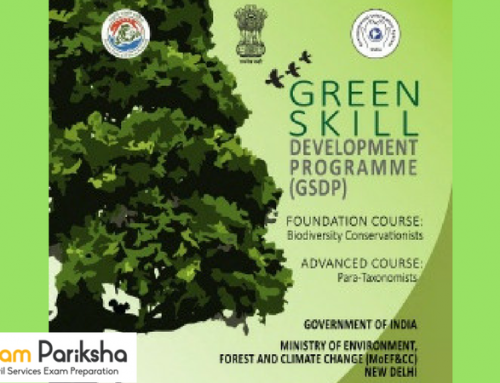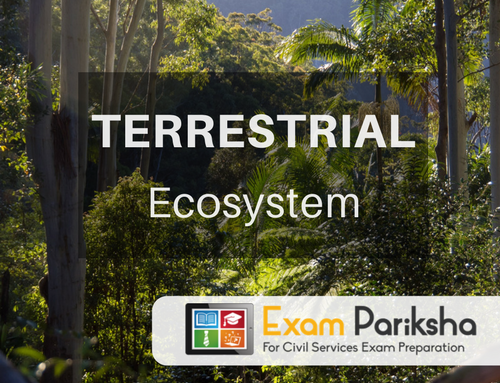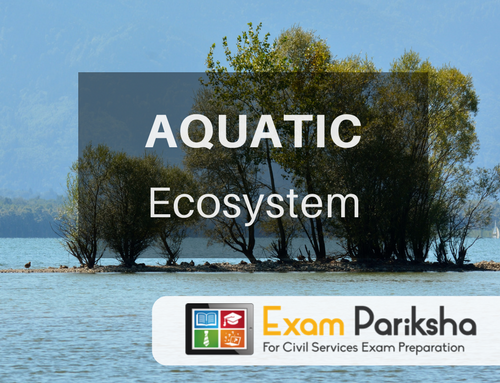Energy Flow:
The Energy Flow is Basic Function of the Ecosystem in the Environment. As it’s the study of the trophic level interaction in an Ecosystem which gives energy flow to the Ecosystem.
Trophic Level interaction:
The Trophic Level interaction starts with the Members of the Ecosystem on the base of the Nutritional Needs as Follows:
- Autotrophs(Producers)
- Heterotrophs (Primary Consumers)
- Heterotrophs (Secondary Consumers)
- Heterotrophs (Tertiary Consumers)
- Heterotrophs (Quaternary Consumers)
While the Energy Flows from Producers to the Subsequent Trophic Level Which Means Always from Producers to the Carnivores.
The Trophic Level includes the 3 Main Concepts:
- Food Chain.
- Food Web.
- Ecological Pyramids.
Food Chain
The Ecosystem is Related to the other Organism feeding Mechanism or Trophic Level. A Food Chain Starts with Producers to the End with Top Carnivores. Small Herbivores Are Consumers of the Vegetable and Convert them to them into the Animal Matter.
Types of the Food Chain:
There are Mainly 2 Types of the Food Chain:
- Grazing Food Chain.
- Detritus Food Chain.
- Grazing Food Chain:
Those Consumers Which Start Their Food Chain by Utilizing the Plant Part as their Food or Food Chain Begins with Green Plants at their Base and the Primary Consumers is Herbivore. In Ecosystem there are Some Phytoplankton is eaten by the zoo Planktons which is Eaten by the Fish or by Pelicans.
- Detritus Food Chain:
A Food Chain Which Starts from Soil or Dead Organism of Decaying Animals and Plant Bodies to the Micro-Organisms ten to the Feeding Organism Called Detrivores and to other Predators.
So the Difference Between the two Chains is the Source of the Energy and First Level of the Consumers. So the Two Food Chains Are Linked with Each Other.
Food Web:
A collection of the Food Chain is Known as the Food Web. As the Same Food Resource is Part of More than One chain. If any of the intermediate Food Chain Removed from the System, the Succeeding Links of the Chain Will Be Affected Largely.
For Example – Grasses may Serve Food for Rabbit and Grasshopper or goat or Cow.
Ecological Pyramids
An Ecological Pyramids Consists a Number of the Horizontal Bars for the Specific Level from the Primary Producers to the Omnivore Onwards.
The Ecological Pyramids Consists the 3 Categories:
- Pyramids of Numbers
- Pyramids of Biomass
- Pyramids of Energy and Productivity.
Pyramids of Numbers:
- In this Level, The Number of the individuals will have decreased from the Lower Level to the Higher Trophic Level.
- This type of the Pyramid Can Be Seen in the Grassland.
- After it the Next Level Higher Trophic Level Primary Consumer is Herbivore.
- The Next Energy Level is the Primary Carnivore.
- The Next Second Trophic Level is the Secondary Carnivore. They Feed Rats.
- The Next Higher Trophic Level is the Number of the Individual Increase.
- While with higher trophic Level, the Number of the Individual Decrease.
- Pyramids of Numbers:
- The Number of the individual will increase from the Lower to the higher trophic Level.
- There Should Be Small Number of the Large Producers.
- This Pyramid is Inverted in shape.
- A Pyramids of the Number Doesn’t Count in the Account So the Size Depends on the Size of the Trophic Level which the Vary.
- It’s Difficult to Count the Organism So the Pyramid Number does not Completely define the Trophic Level for an Ecosystem.
Pyramid of Biomass:
A Pyramid of Biomass is the Collecting of all the Organisms occupying in each Trophic Level Separately and Measuring their Dry Weight.
The Pyramid of Biomass are of two types:
- Upward Pyramid:
They are at the Maximum Level of the Ecosystem. The Biomass of the Next Higher Trophic Level is Secondary Consumers which is Less than the Primary Consumers.
- Inverted Pyramid:
This Pyramid May be in the Inverted Form. As the Producers are Very Tiny Phytoplankton as they grow and Reproduce Rapidly, Hence the Pyramid in the Small Base with Consumer Biomass at the instant Actually Exceeding the Producers and The Pyramid Assumed the Inverted Shape.
Pollutant and Trophic Level:
Pollutants are biodegradable and Non-Biodegradable Which Moves through the Various Trophic Levels in an Ecosystem.
Pollutants are Mainly in the two Form:
- Bioaccumulation.
- Biomagnification.
Bio Accumulation:
It Shows how the pollutants enter into the Food chain. There is an Increase in Concentration of the Pollutant from the Environment to the First Organism in the Food Chain.
Bio Magnification:
It Refers to the Tendency of the Pollutants to Concentrate as they Move from Trophic Level to the Next. As There is an increase in Concentration of a Pollutant from One Link in a Food chain to the Another.
Bio Interaction
The Interaction Between the Organism for its Survival and Functioning of Ecosystem as a Whole.
Types of the Bio interaction:
- Mutualism: Both Species Benefit.
Example: In Pollination Mutualism, the Pollinator gets Food, and the Plant has its pollen Transferred to other Plants.
- Commensalism: One Species Benefits, the other Is Unaffected.
Example: Cow Dung Provides Food and Shelter to the Dung Beetles.
- Competition: Both Species Are Harmed by the Interaction.
Example: If Both Species eat the Same Food and after that, they Suffer the Shortage of the Food.
- Predation and Parasitism: one Species Benefits, the Other is Harmed.
- Amensalism: One Species is Harmed while the Other is Unaffected.
Bio-Chemical Cycle
Energy Flows through the Ecosystems of the Organisms is to Perform the Various Kinds of Work and this Energy is Ultimately Lost as Heat. Carbon, Hydrogen, Oxygen, Nitrogen and Phosphorus as Elements and Compounds makeup 97% of the Mass of our Bodies and Are More Than 95% of the Mass of all the Living Organisms. These Elements or Mineral Nutrients are Always in Circulation Moving from Non Living to Living and Vice versa and This is Known as Fashion Cycle.
Nutrient cycling:
The Nutrient Cycle is Balanced and Stable as Movement of Nutrients from the Environment into Plants and Animals and Again Back to the Environment is Essential for Life.
Types of Nutrient Cycle:
- Based on the Replacement Period It is Known as Perfect and Imperfect Cycle.
- A Perfect Cycle is one which Nutrients Being Replaced as fast and they can.
- Based on their Nature there are Two types of the Cycle as Gaseous and Sedimentary cycle.
- Gaseous Cycle: Where the Reservoir is the Atmosphere or the Hydrosphere.
- Sedimentary Cycle: It is in the Form of the Earth crust.
Gaseous Cycle:
Water cycle (Hydrologic)
The Hydrologic Cycle is the Continuous form of Circulation from the water in the Earth-Atmosphere System which is Driven by Solar Energy.
Water on our Planet is Stored in Major Reservoirs Like Atmosphere, Oceans, Lakes, Rivers, Soils, Glaciers, Snowfields, and Ground Water.
Carbon Cycle
Carbon is Present is the Atmosphere, Mainly in the Form of the Carbon dioxide. It Involves the Exchange of Carbon Between the Atmosphere and Organism. Through the Process of the Respiration and Decomposition of Dead Organic Matter, It Makes a return to the Atmosphere.
In deep Oceans Such Carbon Remained buried for the Millions of the Years Ago which Lift Rocks above the Sea Level
Nitrogen Cycle:
A Nitrogen is Necessary Constituent of Protein and A Basic Building Block of the Living Tissue.
Nitrogen Fixation the On an Earth is Accomplished in the three Different Ways:
- By Microorganisms.
- By Man Using Industrial Process.
- To the Phenomena of thunder and Lightning.
Ammonium Ions can be Directly varying from a Source of Nitrogen by Some Plants or Oxides to Nitrates or Nitrites’ by two Groups of Special Bacteria.
Sedimentary Cycle:
Sedimentary Cycle are the Calcium, Magnesium and Phosphorus.
Phosphorus Cycle:
A Phosphorus Cycle Plays an Important Role in Aquatic Ecosystem and Water Quality. Phosphorus Nutrient is Main Cause for the Excessive growth of the Rooted and Free Floating Microscopic Plant in Lakes.
The Main Storage of the Phosphorus is the Earth Crust. On Land Phosphorus is Mainly Found in the Form of the Phosphates. In the Ocean the Phosphorus accumulates on the Continental Shelves in the form of the insoluble Deposits.
Sulphur Cycle:
The Sulphur Reservoir in the Soil and Sediments where it is Locked in the organic and inorganic Deposits the Sulphur Cycle is Mostly Sedimentary Except tow of it Compounds and Hydrogen Sulphide and Gaseous Component to its Normal Sedimentary Cycle. Atmospheric Hydrogen Sulphide also gets Oxidised into Sulphur. Sulphur Bound into the Living Organism is Carried back to the Soil, to the Bottom of Ponds and Lakes and Seas through Excretion and Decomposition of Dead Organic Material.





